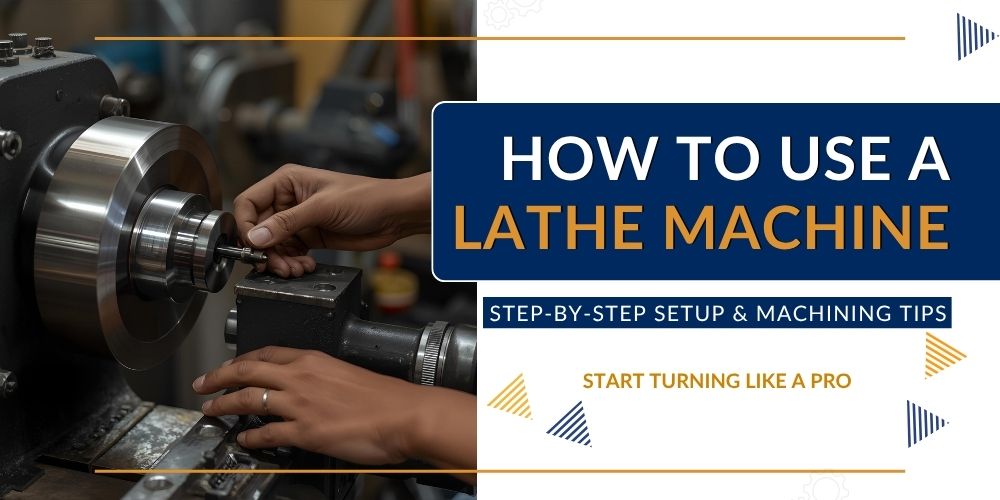
A lathe machine is one of the most versatile tools in any workshop. From shaping metal rods to crafting wooden components, a lathe enables precise cutting, turning, and threading for a wide range of machining operations.
Knowing how to run a lathe, whether it’s a manual lathe or a CNC machine, is essential for achieving smooth, accurate results. Properly operating a manual lathe improves efficiency and safety, while a well-planned CNC lathe setup ensures automated precision for complex and repetitive parts.
Modern CNC turning machines deliver high accuracy and speed, whereas traditional metal turning lathes and wood turning machines are ideal for beginners, hobbyists, and custom work. To get the best performance from any model, be it a rotor turning machine or a Swiss turning lathe, it’s important to follow the correct setup and operation steps.
What Is a Lathe Machine?
A lathe is a machine tool that rotates a workpiece while a cutting tool shapes it. It can work on metals, wood, and other materials. Operators control manual lathes by hand, while CNC lathes follow programmed paths for highly precise operations.
Different types of lathes include:
- Woodturning machines: Ideal for furniture and decorative items.
- Metal turning lathes: Used in workshops and manufacturing.
- Rotor turning machines: Specialized for industrial rotors.
- Swiss turning machines: For small, high-precision components.
Understanding the type of lathe you’re using helps select the right tools and setup for your project.
Essential Lathe Parts and Their Functions
Knowing the lathe parts explained ensures safe and efficient operation. Key components include:
- Headstock: Houses the spindle and drives the workpiece rotation.
- Tailstock: Supports the other end of the workpiece and can hold tools like drills.
- Carriage: Moves the cutting tool along the workpiece.
- Tool Post: Fixes and positions the cutting tool.
- Chucks: Include 3-jaw chucks, 4-jaw chucks, and Jacobs chucks for gripping different workpiece shapes.
For example, a 3-jaw self-centering scroll chuck ensures even clamping for round workpieces, while 4-jaw independent chucks offer flexibility for irregular shapes. Jacobs drill chucks are ideal for holding drill bits during precision drilling.
- Collets & Spindles: Collets hold small or precision workpieces; spindles rotate the workpiece accurately.
Using high-quality components such as ER16 collet nuts or 5C collets helps maintain precision and reduce vibration during machining.
How to Set Up a Lathe for the First Time
Proper setup is crucial for both manual and CNC turning operations:
- Level the Machine: Ensure the lathe sits on a stable, flat surface.
- Install the workpiece: Fasten it with a chuck or collet.
- Select the Tool: Choose appropriate cutting tools for turning, facing, or threading.
- Calibrate Feed and Speed: Adjust spindle speed and feed rates according to material.
- Safety Check: Ensure that guards are in place and that personnel wear safety equipment.
Following these steps reduces errors and improves the precision of turning operations.
Step-by-Step Turning Operations on a Lathe
Turning Operation (Manual & CNC)
Turning machining removes material from the outside diameter of a workpiece. On a CNC turning machine, the process is automatic. On a manual lathe, the operator moves the cutting tool carefully along the workpiece.
Facing Operation
This creates a flat surface at the end of the workpiece. Proper alignment of the tool and workpiece ensures accuracy.
Threading Operation
Utilized for forming screw threads on a rod or cylinder. Both manual and CNC methods require precision and correct tool selection.
For detailed examples of turning lathe machines and projects, see our Beginner’s Guide to Using a Micro Lathe.
Types of Turning Machines and Their Uses
- Manual Lathe Machine: Great for learning and hobby projects.
- CNC Turning Lathe: Ideal for high-precision automated work.
- Swiss Turning Machine: Perfect for small, intricate components.
- Rotor Turning Machine: Used in industrial applications like turbines and motors.
Understanding the machine type helps optimize cutting, feed, and spindle speed for different materials.
Safety Tips and Common Mistakes
- Consistently use safety equipment and secure loose attire.
- Check that you securely mount the workpiece.
- Start with slow spindle speeds, especially on new projects.
- Keep cutting tools sharp and properly aligned.
- Avoid rushing threading or facing operations to maintain precision.
Manual vs CNC Lathes-Which Should You Use?
Manual lathes are cost-effective, flexible, and perfect for beginners or custom projects. CNC lathes and CNC turning machines provide better precision and consistency. This makes them perfect for industrial production and complex designs. Choosing the right type depends on the project’s scale, material, and the required accuracy.
Final Tips for Smooth and Accurate Machining
- Regularly clean and lubricate the lathe.
- Use high-quality chucks and collets for stability.
- Practice various turning machining techniques on scrap material before proceeding with the final work.
- Pair your lathe with the right accessories to enhance performance, like those listed in our Accessories for Taig Lathe or Mill.
Using quality drill chuck arbors and chuck adapters ensures stable alignment and accurate machining results.
FAQs
Q: What is CNC turning, and how is it different from manual turning?
CNC turning automates the cutting process with precisely programmed paths, while manual turning requires operator control.
Q: Is a woodturning machine suitable for metal tasks?
No, manufacturers design wood-turning machines for soft materials. They cannot handle the hardness or heat from metal.
Q: What’s the difference between a CNC turning lathe and a Swiss turning machine?
Swiss turning machines specialize in producing small, precise parts. Standard CNC turning lathes work with medium to large pieces.

